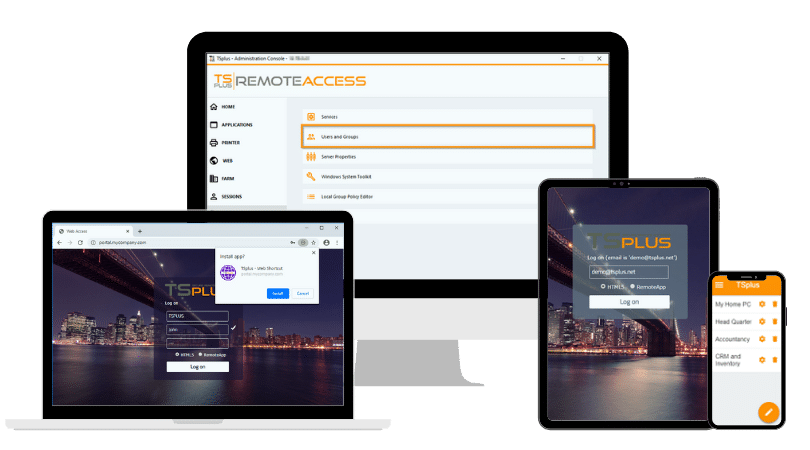What Is Microsoft RDP?
Understanding Microsoft Remote Desktop Protocol (RDP)
Microsoft Remote Desktop Protocol (RDP) is a proprietary protocol developed by Microsoft that allows users to remotely access and control a Windows-based computer or server from another device. RDP is a part of the Windows operating system family and is available in Windows Professional, Enterprise, and Server editions.
Key Characteristics of Microsoft RDP
- Proprietary Protocol: RDP is developed and maintained by Microsoft.
- Secure Communication: Supports encryption using SSL/TLS (Transport Layer Security).
- Multi-Session Support: Supports multiple simultaneous connections on Windows Server editions.
- Cross-Platform Access: Compatible with Windows, macOS, Linux, iOS, and Android.
RDP Architecture and Protocol Stack
1. Client-Server Model
RDP operates on a client-server model, where:
- The client is the device initiating the remote connection (e.g., a laptop or mobile device).
- The server is the Windows computer or server being accessed.
2. Communication Protocol
RDP communicates over TCP port 3389 by default but can be configured to use a different port for security purposes. The protocol uses a combination of:
- Input Redirection: User actions (keyboard, mouse) are sent from the client to the server.
- Display Protocol: The server sends graphical updates to the client, which are rendered on the client’s screen.
3. Security Mechanisms
- Encryption: RDP uses SSL/TLS for secure communication.
- Network Level Authentication (NLA): An additional security layer that requires users to authenticate before establishing a session.
- Secure Gateway (RD Gateway): Provides secure remote access over the internet by tunneling RDP traffic through HTTPS.
How Does Microsoft RDP Work?
Overview of the RDP Connection Process
Microsoft RDP establishes a remote connection using a multi-step process that ensures secure and efficient communication between the client and server.
1. Initial Connection Request
- The client device uses the Remote Desktop Client application (available for Windows, macOS, iOS, and Android).
- The client specifies the IP address or hostname of the target computer.
- If the connection is being made over the internet, an RD Gateway can be used for secure access.
2. Authentication Phase
- Network Level Authentication (NLA) is triggered if enabled, requiring the user to authenticate before a session is established.
- The server verifies the credentials using Windows Authentication or Active Directory (for domain environments).
3. Secure Session Establishment
- Once authenticated, an encrypted channel is established using SSL/TLS.
- The client and server negotiate session parameters, including display settings, device redirection, and audio settings.
4. Data Transmission
- The server continuously sends graphical updates to the client using an optimized encoding protocol.
- User inputs (keyboard, mouse actions) are captured by the client and sent back to the server.
5. Session Management
- The server maintains the active session and applies security and resource policies.
- The client can disconnect, reconnect, or terminate the session as needed.
Key Features of Microsoft RDP
Feature Overview
Microsoft RDP offers a wide range of features that make it a versatile remote access solution for IT professionals.
Cross-Platform Compatibility
Supported Platforms:
- Windows: Native Remote Desktop Client.
- macOS: Microsoft Remote Desktop from the Mac App Store.
- Linux: Open-source clients like Remmina or FreeRDP.
- iOS and Android: Microsoft Remote Desktop apps available in App Stores.
How Cross-Platform Access Works:
RDP clients for non-Windows platforms communicate with the remote Windows machine using the RDP protocol. Microsoft provides platform-specific clients that offer a consistent user experience.
Advanced Security Mechanisms
Network Level Authentication (NLA):
- Ensures users must authenticate before a session is established.
- Reduces exposure to brute-force attacks.
SSL/TLS Encryption:
- Provides a secure communication channel between client and server.
- Supports custom certificate deployment for enhanced security.
Smart Card Authentication:
- Enables two-factor authentication (2FA) using physical smart cards.
- Ideal for high-security environments.
Multi-Session Support
Single-User vs. Multi-User Environments:
- Windows Professional/Enterprise: Single active user session.
- Windows Server Editions: Multiple concurrent sessions, ideal for Remote Desktop Services (RDS) environments.
Session Management Features:
- Administrators can disconnect, log off, or shadow user sessions.
- Resource allocation for each session can be controlled (CPU, RAM).
Resource Redirection
Local Resource Mapping:
- Redirects local drives, printers, USB devices, clipboard data, and audio to the remote session.
- Configurable via the Local Resources tab in the RDP client settings.
Advanced Redirection Options:
- Specify which local devices are redirected.
- Control audio playback and recording.
Connection Optimization
Display and Performance Settings:
- Configure screen resolution, color depth, and refresh rate.
- Adjust bandwidth usage through the Experience tab.
Custom Configuration via RDP Files:
- Save and reuse custom connection settings using .rdp files.
- Automate connections with pre-configured RDP files.
How to Set Up Microsoft RDP
Step-by-Step Guide to Configuring RDP
1. Enabling Remote Desktop on Windows
- Go to Settings > System > Remote Desktop.
- Toggle Enable Remote Desktop.
- Click Advanced Settings and ensure Network Level Authentication (NLA) is enabled.
2. Configuring User Access
- Click Select users that can remotely access this PC.
- Add authorized users (local or domain accounts).
3. Connecting to the Remote Desktop
- Launch the Remote Desktop Client.
- Enter the IP address or hostname of the target computer.
- Provide your login credentials.
Best Practices for Using Microsoft RDP
1. Secure Your RDP Access
- Use Network Level Authentication (NLA).
- Implement VPN access for remote RDP connections.
- Regularly update RDP clients and servers.
2. Optimize Performance
- Adjust display settings for low-bandwidth environments.
- Disable unnecessary resource redirection.
3. Monitor and Audit RDP Sessions
- Enable event logging for RDP sessions.
- Regularly review security logs.
Advantages of Using Microsoft RDP
Microsoft RDP offers several advantages that make it an essential tool for IT professionals and businesses alike:
- Cost-Effective Remote Access: Since RDP is built into Windows Professional, Enterprise, and Server editions, it eliminates the need for purchasing third-party remote access tools, reducing overall costs. Organizations leveraging existing Windows licenses can provide remote access without incurring additional expenses.
- Enhanced Productivity: With RDP, users can securely access their work applications, files, and network resources from any location, ensuring uninterrupted workflows. This flexibility is particularly useful for remote teams, IT support, and multi-location businesses.
- Easy Integration: RDP is natively integrated into the Windows operating system, making setup and configuration straightforward for IT administrators. The familiar interface and native support reduce the learning curve for users and administrators alike.
- Centralized Management: RDP supports centralized management of multiple remote desktops in server environments, enabling IT administrators to monitor, maintain, and troubleshoot remote systems efficiently. This makes it ideal for managing enterprise networks, data centers, and remote user environments.
- Scalability: With Remote Desktop Services (RDS) on Windows Server, organizations can scale their RDP deployment to support multiple simultaneous users, making it suitable for large enterprises and cloud-hosted environments.
Potential Limitations and Alternatives
While Microsoft RDP is a powerful and versatile remote access tool, it is not without its limitations, which may impact its suitability for some environments:
- Licensing Requirements: Microsoft RDP is only available on Windows Pro, Enterprise, and Server editions, which means users with Windows Home cannot access its full capabilities without upgrading. This can result in additional licensing costs for organizations.
- Security Concerns: Despite robust encryption options, misconfigurations can expose RDP servers to unauthorized access or brute-force attacks. Ensuring secure configurations, such as enabling Network Level Authentication (NLA) and using a secure gateway, is essential.
- Performance Issues: RDP performance may degrade over low-bandwidth connections, resulting in latency, screen lag, or poor-quality graphics. Optimization through bandwidth management, display settings, and network enhancements can mitigate these issues.
- Complexity in Large Environments: For large-scale deployments, managing RDP access for multiple users and devices can become complex without advanced tools like Remote Desktop Services (RDS) or third-party solutions like TSplus Remote Access, which provide enhanced security, centralized management, and user-friendly web-based access.
Why Choose TSplus for Remote Access?
At TSplus, we offer a robust and cost-effective alternative to Microsoft RDP. Our solution is designed to provide secure, reliable, and user-friendly remote access for businesses of all sizes. With advanced features such as web-based access, multi-device compatibility, and customizable security settings, TSplus is a comprehensive tool for IT professionals.
Conclusion
Microsoft Remote Desktop Protocol (RDP) is a powerful and versatile tool for IT professionals seeking secure, remote access to Windows systems. With its robust feature set, including multi-session support, cross-platform compatibility, and advanced security options, RDP is an essential component of modern IT infrastructure. However, understanding its limitations and implementing best practices is crucial for maintaining security, performance, and reliability in remote access environments.
TSplus Remote Access Free Trial
Ultimate Citrix/RDS alternative for desktop/app access.Secure, cost-effective,on-permise/cloud









)



)
)
)
)



